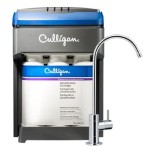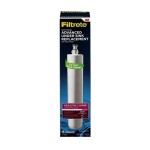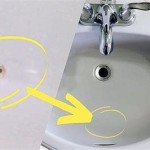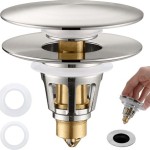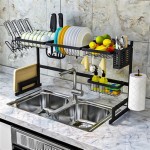Dish Rack for Kitchen Sink: A Guide to Choosing and Using
A dish rack is an essential kitchen tool, providing a dedicated space for air-drying washed dishes and cookware. Selecting the right dish rack can significantly impact kitchen organization and hygiene. This article explores the various types of dish racks available, factors to consider when choosing one, and best practices for its use and maintenance.
Types of Dish Racks
Dish racks are available in a wide array of styles and configurations to suit different kitchen sizes and needs. Understanding these variations is crucial for making an informed purchase.
Over-the-Sink Dish Racks: These racks are designed to span the width of the kitchen sink, maximizing counter space. They typically feature a draining board that directs water directly into the sink, preventing puddles on the countertop. Over-the-sink racks are particularly beneficial for smaller kitchens where counter space is limited. However, they may obstruct access to the sink faucet.
In-Sink Dish Racks: Designed to fit inside the sink basin, these racks are excellent for maximizing counter space. They are typically compact and ideal for drying smaller items like glasses and cutlery. In-sink racks are particularly convenient for individuals living in apartments or smaller homes. However, they may limit the sink's usability for other tasks while the rack is in place.
Countertop Dish Racks: These are the most common type of dish rack, offering a dedicated space on the countertop for drying dishes. Countertop racks come in various sizes and configurations, often including compartments for plates, bowls, cutlery, and even cutting boards. While they provide ample drying space, they do occupy valuable counter real estate.
Wall-Mounted Dish Racks: For kitchens with extremely limited counter space, wall-mounted dish racks offer a practical solution. These racks are installed above the sink or counter, allowing dishes to drip dry directly into the sink. While they save space, they require installation and may not be suitable for heavier items.
Factors to Consider When Choosing a Dish Rack
Selecting the right dish rack involves evaluating several key factors. These considerations will ensure the chosen rack effectively meets individual needs and preferences.
Size and Capacity: The dimensions of the dish rack should correspond to the available space and the typical volume of dishes washed. Larger households may require a more substantial rack, while smaller households or individuals can opt for more compact options.
Material and Construction: Dish racks are commonly made from stainless steel, plastic, or coated wire. Stainless steel is known for its durability and resistance to rust, while plastic is lightweight and often more affordable. Coated wire racks provide good airflow but can be susceptible to chipping or rusting over time. The construction quality should be sturdy and stable to prevent wobbling or tipping.
Drainage System: An effective drainage system is crucial for preventing water buildup and promoting hygienic drying. Look for racks with sloped draining boards or integrated drainage spouts that direct water into the sink. Removable drip trays are also beneficial for easy cleaning.
Features and Accessories: Some dish racks offer additional features like cutlery caddies, cup holders, and cutting board slots. Consider which features would be most useful based on individual dishwashing habits.
Maintaining Your Dish Rack
Proper maintenance is essential for prolonging the lifespan of a dish rack and ensuring hygienic drying conditions.
Regular Cleaning: Dish racks should be cleaned regularly to prevent the buildup of food particles, soap residue, and mildew. Washing the rack with warm soapy water and a sponge or brush is typically sufficient. For stubborn stains or mildew, a solution of baking soda and vinegar can be effective.
Proper Drying: After cleaning, ensure the dish rack is thoroughly dry before storing or using it again. Excess moisture can promote the growth of bacteria and mildew.
Inspect for Damage: Regularly inspect the dish rack for any signs of damage, such as rust, chipping, or cracks. Replacing a damaged rack promptly prevents further deterioration and maintains hygienic drying conditions.
Choosing the right dish rack and maintaining it properly contributes to a more organized and hygienic kitchen environment. By considering the various types, factors, and maintenance practices outlined in this article, individuals can make informed decisions and ensure their dish rack effectively serves its purpose for years to come.

Hapysa Dish Drainer Kitchen Rack Steel Multipurpose Stainless Roll Up Sink Drying In India

Shelzi Dish Drainer Kitchen Rack Carbon Steel Sink Drying 2 Tier Over Storage Space Saver Organizer In India

Kruvad Roll Up Dish Drying Rack Stainless Steel Over Sink Multi Use Foldable Dishes Holder Drain For Kitchen Countertop

Rectangular Double Layer Kitchen Sink Drying Rack Small Shelves 2 Size Dimensions Standard At 2000 Piece In Chennai

Metal Kitchen Dish Drying Rack With Removable Drain Board 2 Tier Large White At 1200 Piece Katargam Surat Id 2854404819130

Youbee Double Layer Plastic Kitchen Sink Large Dish Rack Organizer Drainer Basket At 489 Instant Delivery Zepto

Ibell Dish Drainer Kitchen Rack Carbon Steel Dr185 Drying Bartan Stand Over Sink Organizer Shelf For Utensils In India

Kitchen Sink Countertop Foldable Collapsible Dish Drainer Drying Rack Wall Hanging Easy Installation Accessories And Storage Holders Racks Made In China Com

Rust Resistant Sink Dish Drying Rack Kitchen Over Storage Organ

Limetro Steel Dish Drainer Kitchen Rack Over The Sink Utensils Stand For After Wash 28x28 At Best S In India Jio

